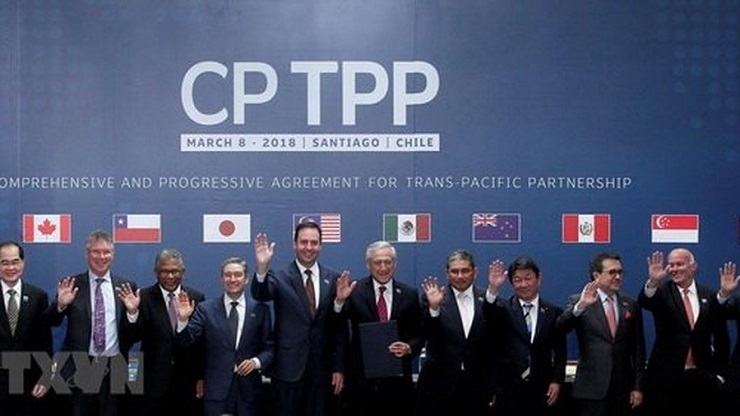Such a long name (The Comprehensive and Progressive Agreement for the Trans-Pacific Partnership, CPTPP) will now designate the largest collective free trade zone in the region, around which difficult negotiations have been conducted for almost 10 years.
On 8 March in the capital of Chile, Santiago, the foreign ministers of the 11 participating countries signed the Agreement, which will further have to be ratified by their parliaments. Sixty days after this procedure is carried out by the parliaments of the first 6 countries, the CPTPP will come into force. That does not mean that all the final goals stated in the document will be immediately achieved. This will take years of patient work.
The association now includes five Asian countries (Japan, Singapore, Malaysia, Vietnam, Brunei), four countries from the Americas (Canada, Mexico, Chile, Peru), as well as Australia and New Zealand. Their combined GDP amounts to about 13.5% of the world.
Meanwhile, a little more than a year ago the project of the future association had a much shorter name (The Trans-Pacific Partnership, TPP). But that included another country, and its total GDP reached 40% of the world.
The fact is that this 12th country was the world economic (and also military-political) leader – the US, which, in fact, acted as the main “motor” of TPP. The previous US administration saw the goal of the project, rather, as a way to create an economic base for military and political confrontation with the main geopolitical opponent, that is, China.
But US president, Donald Trump, who took office in January 2017, had built his campaign around a slogan understandable to the average American: we’re done feeding our allies and partners. These, using “free” American security services, have annually and in a huge way outplayed the ‘big brother’ in trade. Together with the largest ‘partner’ (that is, China) this disadvantage for US was estimated at a hefty 800 billion dollars.
Therefore, Donald Trump continues, let the allies fork out for their own defence, and in the fight against China we will go the other way: we will lower taxes for our own companies and raise barriers for foreigners trading on the American market. And if we hurt our allies in the process? Well, they had it coming.
The Trump administration’s new foreign policy has brought about such memes as ‘protectionism’ and ‘economic war’, with TPP being just the first victim. The January 2017 exit of the US from the project seemed to put a nail in its coffin.
But it was the policy of isolationism by the world’s leading economy that stimulated the remaining 11 members of the TPP to revive the project. The decisive role was played by Japan, who took up the mantle of ‘motor’.
The popular Japanese newspaper Mainichi Shimbun sees a certain symbolism in the fact that the signing of the CPTPP agreement coincided with the announcement of the intention to introduce duties on steel and aluminum industry products imported by US. Specific manifestations of ‘protectionism’ in American trade policy will be one of the main topics of the upcoming talks in April between Japanese Prime Minister Shinzo Abe and President Trump.
Comments on the signing of the CPTPP have stressed that in conditions of self-withdrawal of the leading world power from participation (previously decisive) in an extremely important regional project, its salvation by Japan illustrates a sharp increase in the role of the latter in the affairs not only of the Indian and Pacific oceans, but also of the world as a whole.
In doing so, reference is made to the conclusion in the summer of 2017 of the EU-Japan Economic Partnership Agreement (EPA). Reaching the final goals of this document will also take a lot of time. It cannot be otherwise.
The attitude the world’s second biggest power, China, towards the CPTPP in recent months has undergone remarkable changes which reflect the radical shifts in the world political game that began with the election of Donald Trump as president of the world’s leading power. For years, the negative perception by Beijing of the agreement preceding the CPTPP was determined by the politicization of this project by the Obama administration, that is, its obvious anti-Chinese orientation.
Now we are witnessing a sharp change in tonality in Chinese assessments of the CPTPP, which has three main reasons. First off, the main opponent left the project, taking with it the very anti-Chinese political component.
Secondly, the fact of the CPTPP’s creation fits into the continuing globalization trend in the world economy, which China now aspires to be leading. This was absolutely clearly stated at last year’s forum in Davos by Chairman Xi Jinping.
The former leader of globalization is now designated by the Chinese Global Times as a source of ‘nationalism and chaos in the global economy’. The illustrator from the same Global Times graphically depicted the conflicting economic trends initiated by the US and CPTPP.
Thirdly, the current year 2018 may be the year of mending political relations between the PRC and Japan, who is practically leading the CPTPP. This possibility, (potentially) extremely important for the situation in the region, has been previously discussed in the NEO.
In this regard, the broader project of a free trade zone is expected to be updated to include 10 ASEAN countries + PRC, Japan, South Korea, India, Australia and New Zealand (ASEAN + 6). The same configuration is sometimes referred to as the ‘Regional Comprehensive Economic Partnership’ (RCEP).
Problems in the sphere of Sino-Japanese relations have so far hampered the implementation of the ASEAN + 6 project, just as they did hamper the narrower project between the PRC, Japan, and South Korea.
Meanwhile, of all the multilateral configurations of recent years, intended to allow a free flow of goods and services, the CPTPP is the only project to have reached the home stretch.
Vladimir Terekhov, expert on the issues of the Asia-Pacific region, exclusively for the online magazine “New Eastern Outlook.”
